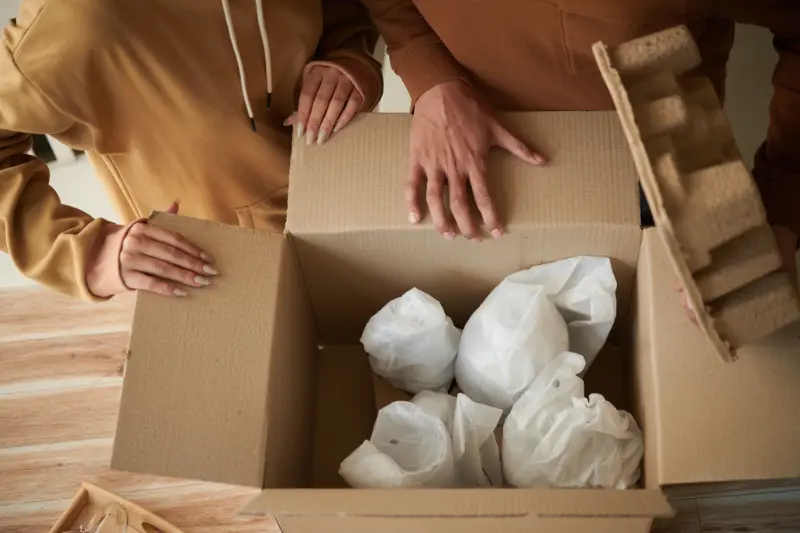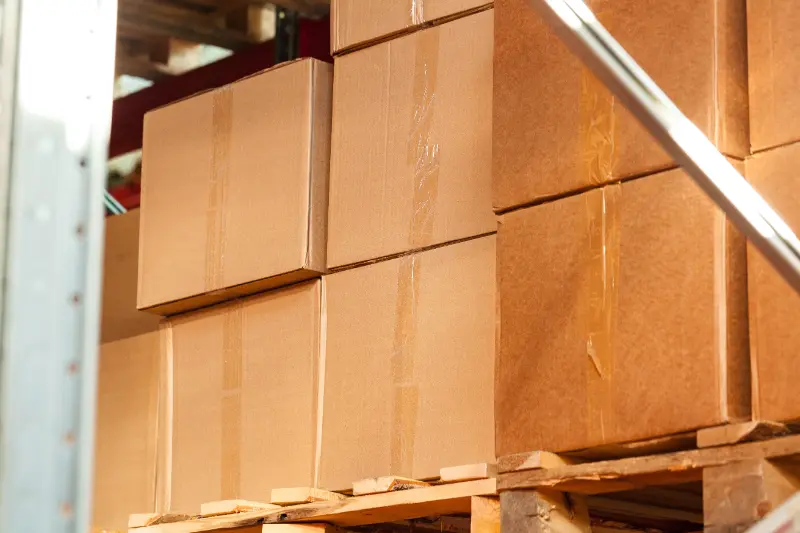Securing your belongings for long-term storage doesn’t have to be daunting. Our guide cuts through the complexity, delivering the must-know methods to keep your items safe and sound over extended periods. There is no fluff—just straightforward advice on prepping, packing, and protecting belongings for long-term storage, ensuring what matters most to you remains in top condition.
Key Takeaways
- Proper preparation, including thorough cleaning, repairing, and strategic packing, is essential for preserving items in long-term storage.
- Selecting the right packing materials and storage techniques, such as sturdy boxes, protective wrapping, and climate-controlled units, protects items from damage.
- Regular maintenance, clear labelling, and organisation facilitate ease of access and help to ensure belongings remain in good condition in long-term storage.
Preparing Your Belongings for Long-Term Storage
Just like you wouldn’t jump into the deep end of a pool without knowing how to swim, you wouldn’t want to dive into long-term storage without proper preparation. Getting your belongings ready for storage is more than just tossing items into boxes; it’s about understanding what truly requires long-term storage and ensuring they are in the best condition for storage. Remember, a thorough inventory of items is the first step before packing for long-term storage.
Cleanliness is key to warding off damage during storage. By cleaning your store items thoroughly, you prevent dirt, stains, or odours from setting in. Moreover, keep your items dust-free to maintain their condition during storage. Disassembling bulky items like furniture not only saves space but also minimises the risk of damage.
When packing, arrange items strategically in boxes with heavier items at the bottom for stability and fill gaps to prevent content movement.

Inspect and Clean Items
Before storing items, a thorough inspection and cleaning are essential. This prevents bacteria, mould, and deterioration from damaging your items during storage. Whether it’s your grandma’s antique chair or your favourite leather jacket, detailed cleaning is necessary to avoid persistent contamination.
Just think of it as a spa day for your belongings, pampering them with a thorough clean before their long-term stay.
Repair Damaged Items
Next in line is repairing any damaged items. A slightly cracked mirror or a chair with a loose leg needs some TLC before storage. Repairing these items before storing them long-term can prevent further damage and preserve their value.
Even if they’re damaged but salvageable, these items can be stored for potential future use.
Choosing the Right Packing Materials
Choosing the right packing materials is like choosing the right armour for a knight. It should provide the right protection, fit perfectly, and be of good quality. The same goes for your belongings; quality packing materials ensure the safety and preservation of your items over extended periods.
Sturdy boxes provide better protection for stored items and reduce the risk of damage. They are the knights in shining armour for your fragile items, providing an additional layer of protection. For electronic items, using their original packaging is advantageous as it is specifically designed for their protection. And while plastic bags might seem handy, they are not advisable for long-term storage as they can trap moisture, promoting mould or mildew growth.
Sturdy Boxes and Containers
When it comes to packing your items, think outside the box—or rather, think about the box! Speciality boxes, such as double-walled or compartmentalised boxes, provide extra protection for delicate items.
Airtight containers are also essential for long-term storage. They act as shields, preventing moisture, dust, and dirt from causing damage to your belongings.
Protective Wrapping
Much like a knight needs a shield, your fragile items need protective wrapping. Bubble wrap is an excellent ally in this aspect, providing robust protection for your delicate items.
Remember to ensure a minimum of a two-inch-deep bubble wrap cushion between the object and the container, filling any remaining spaces to prevent movement within the box. But be wary of using bubble wrap for heavy items as the bubbles might burst, reducing its ability to protect.
Fragile items should be wrapped individually for added protection, and to prevent discolouration and dust, acid-free tissue paper should be used for delicate items during long-term storage.
Organising and Labeling Belongings
Now that your belongings are clean, repaired, and packed, the next step is organising and labelling them. Imagine walking into a library where books are scattered without any order. Finding a specific book would be a nightmare! The same goes for your storage unit. Proper organisation and clear labelling of your belongings make the retrieval process easier and help declutter the storage space.
Categorising items by room can keep your belongings organised, while colour-coded labels help quickly identify the appropriate room each box goes in after a move. Clear labelling not only ensures the organisation of belongings but also facilitates easy tracking down of items when needed. Plus, creating a visual layout of the storage unit upon arranging boxes helps locate items swiftly and contributes to an orderly storage environment.
Categories Items
Categorising your items before storage is like creating a map for your future self. Using dedicated moving boxes for specific categories of items ensures similar items are kept together and organised.
Grouping items by the room they belong in or the activity they are used for can greatly improve the organisation within a storage unit. Similar items should be stored together in the same area to maintain order and ease of access.
Label Boxes Clearly
Next, we move on to labelling. Here are some tips for labelling your boxes:
- Label boxes with content descriptions to make identification easy when items need to be retrieved.
- For delicate items, include ‘fragile’ labels.
- For categories, use specific terms like ‘kitchenware’ or ‘seasonal items’.
This simplifies the retrieval process, making it quicker and more efficient.
Proper labelling not only facilitates future retrieval but also ensures items are handled correctly to avoid damage.
Selecting the Ideal Storage Unit
Finding the ideal storage unit is like finding a home for your belongings. It needs to have:
- The right size
- A convenient location
- Necessary security measures
- Climate control
The location of the storage facility can impact the rental cost, with potentially more affordable options available outside of urban centres. And remember, different self-storage units offer varying levels of security, from self-service storage with personal locks to full-service units that include restricted access and additional services.
Climate-controlled storage units, although more expensive, provide essential protection for items sensitive to temperature and humidity fluctuations. Choosing a climate-controlled storage unit is a wise decision, especially for long-term storage unit needs. Opting for a secure storage unit is also crucial for ensuring the safety of your belongings. And don’t forget to check online reviews of storage facilities to gauge customer satisfaction and reliability.
Climate-Controlled Units
Now, let’s delve deeper into climate-controlled units. These are specially designed to regulate temperature and humidity levels, protecting your belongings from damage over time.
Think of climate-controlled units as cosy shelters for valuable items like antique books, electronics, and antiques, preserving their condition and functionality. These units offer a stable environment by protecting sensitive items from harmful temperature and humidity fluctuations.
Security Measures
Security is paramount when it comes to your belongings. Advanced security measures, including fully monitored CCTV systems, protect your stored items.
With modern security features, facilities like MIGHTY Self Storage ensure the safety of both domestic and commercial customers’ belongings through CCTV monitoring and individually alarmed units. It’s essential to verify the presence of video monitoring and adequate lighting for the security and safety of items in storage. And let’s not forget that additional security measures like on-site security personnel and insurance options for stored items also add to overall safety.
Proper Storage Techniques
So, you’ve prepared, packed, organised, and found the perfect storage unit. What’s left? Implementing proper storage techniques to maximise space and protect your belongings. Consider how you will arrange your items within the unit, ensuring heavier boxes are at the bottom and lighter ones on top to prevent damage. Additionally, understanding the differences between facilities, such as a warehouse vs fulfilment centre comparison, can help you determine the best option for your storage needs. Utilizing vertical space effectively will also enhance accessibility and efficiency in your storage strategy.
Use the following tips for effective storage:
- Use breathable materials like cardboard boxes instead of plastic bags to promote air circulation and reduce the risk of mould and mildew.
- Vacuum seal soft items to save space and protect against vermin, mould, and moisture.
- Nest smaller items inside larger ones to utilise space more efficiently.
- Place heavier boxes at the bottom of stacks to prevent crushing lighter and fragile items.
Elevate Items
One important storage technique is elevating items. Moisture is the biggest enemy when it comes to storing items for a long time, making it essential to keep items off the ground.
Elevating belongings on pallets can prevent damage from potential floods or spills, which is particularly important when using cardboard boxes for storage. Utilising vertical space by storing items on shelves can maximise floor space in the storage unit, offering additional protection and space efficiency.
Create an Accessible Layout
Creating an accessible layout in your storage unit is like designing a floor plan for a house. It maximises space and ensures easy access to your items.
Some tips for organising your storage unit are:
- Position frequently used items near the storage unit’s entrance for easy access.
- Store frequently used items towards the front of the unit for improved accessibility.
- Use sturdy shelves to keep boxes and items organised.
- Consider using pallets and modular shelving systems to optimise vertical space and keep items off the ground.
These tips will help you keep your storage unit organised and make it easier to find and access your belongings. Consider categorizing your items by type or purpose, which can save time when you need to retrieve specific things. For instance, keeping your gap year travel essentials in a designated section can simplify packing and ensure you have everything ready for your adventure. Regularly reviewing and reorganizing your unit will also help you maintain order and efficiency over time.
And remember, arranging items to create an aisle allows for easier access and removal of stored items. Leaving space around the perimeter of the storage unit prevents moisture buildup and enhances air circulation.

Maintaining Your Belongings in Long-Term Storage
Once your belongings are safely stored, the job isn’t over yet. Regular maintenance is crucial to ensure your items remain in good condition.
Visiting the storage unit regularly ensures that items remain in good order and that any potential issues are addressed promptly. Follow established maintenance tips to maintain the quality and value of items in long-term storage. Planning a post-storage check-back brings peace of mind by ensuring items are secure over the long term.
Regular Inspections
Regular inspections are like routine health check-ups for your stored items. They ensure your items are in good shape and nip any potential issues in the bud.
Frequent inspections facilitate the early detection of issues, such as damage or pest infestations, which can then be addressed promptly. Rotating the items in storage can be a preventive strategy to reduce the risk of damage by evenly distributing weight and pressure.
Update Insurance Coverage
While we hope for the best, it’s wise to prepare for the worst. Updating your insurance coverage for stored items offers financial protection and peace of mind against unexpected events like theft, fire, or flooding.
Storage insurance is designed to protect against specific incidents, ensuring that the value of your stored items is covered. Remember, photographing your items before storage is an important step for insurance purposes. It helps document the condition and existence of your belongings, aiding in any potential future claims.
MIGHTY Self Storage: Your Partner in Long-Term Storage Solutions
If you’re looking for a storage solution that ticks all the boxes, MIGHTY Self Storage is your go-to choice. Here’s why:
- MIGHTY is a family-owned business with over 50 years of experience in storage solutions.
- They offer personalised customer service to ensure your needs are met.
- MIGHTY has expertise in providing the right storage solution for you.
Strategically located in South Wigston, Leicester, it provides secure parking options and convenient 7-day access. Catering to both individuals and businesses, MIGHTY is a cost-effective solution for a variety of needs, from excess inventory to personal belongings.
With competitive pricing and discounts available for long-term contracts and certain professions, MIGHTY is an affordable option.
Summary
In conclusion, long-term storage is much more than just finding a space to stash your belongings. It’s about careful preparation, choosing the right materials, organising and labelling items, selecting the ideal storage unit, implementing proper storage techniques, and regular maintenance. With these steps, you’ll ensure your belongings are stored safely, efficiently, and without damage. So whether you’re moving, decluttering, or just need extra space, remember these tips to make your long-term storage experience a breeze.
Frequently Asked Questions
How do you protect items in non-climate-controlled storage?
To protect items in non-climate controlled storage, ensure they are clean and dry before moving them in, and strictly avoid bringing in any food or liquids. It’s advisable to tightly seal all wood and upholstered furniture in plastic or shrink wrap for protection.
What should I do before storing items long-term?
Before storing items long-term, make sure to clean them thoroughly, repair any damage, and inspect them for potential issues. This will help maintain their condition.
What kind of packing materials should I use for long-term storage?
For long-term storage, use sturdy boxes or containers with protective wrapping, such as bubble wrap, to prevent damage. Avoid using plastic bags, as they can trap moisture and cause problems over time.
How should I organise my items in a storage unit?
Organise your items in a storage unit, categorise your items, label your boxes clearly, and create an accessible layout in your unit for easy access.
What should I consider when choosing a storage unit?
When choosing a storage unit, consider factors like size, location, security measures, and climate control to ensure it meets your storage needs.
